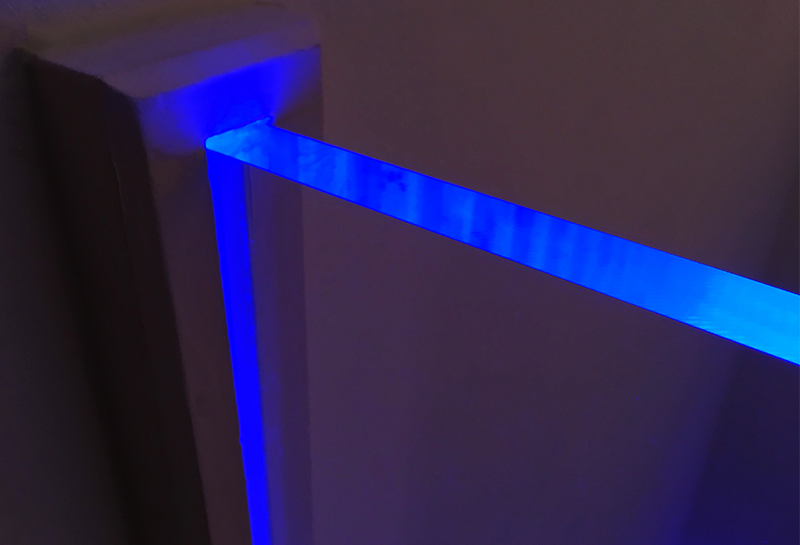
If you want to illuminate acrylic with LED, you can go about it in numerous ways. You can turn it into the cutest little lights, create an illuminated headboard behind your bed, or make a floating ceiling. You will achieve the best results with LED strips on rolls, already fitted with a self-adhesive tape.
Our blogs about placing acrylic in interiors generate lots of positive reactions. People are surprised with the result when they place acrylic in their interiors for the first time. Acrylic is a rewarding material for interior design, thanks to its many colours and different transparencies. With the use of lighting, you can add an extra dimension to an acrylic panel. LED lighting in particular offers endless possibilities. In this blog, we give the most important tips to achieve the most beautiful results.
There are various LED strips on the market, a distinction can be made between flexible LED strips on a roll, and LED strips mounted in a plastic housing. You can often find the latter in DIY stores. However, you get the best results with LED strips supplied on rolls, these LED strips often also have a self-adhesive backing. The biggest advantage of these LED strips is the possibility of mounting the LEDs directly onto the acrylic.
Acrylic has excellent light-conducting properties, light ‘flies’ effortlessly through the sheets. This applies to both clear and coloured acrylic sheets with the exception of opal sheets. For the sheet to ‘light up’, an unevenness must be made in or on the material. You also need to polish the edges so that the light can shine through the sheet.
LED strips have a very wide beam angle, in principle, how you position the sheet on the LED strip is not very important and you can even use a relatively thin sheet thickness. However, we don’t like tinkering and we do like a good end result, so we recommend a sheet thickness of at least 8 millimetres. This thickness ‘catches’ all the light from an LED, which will maximise the exposure effect.
As mentioned, transparent acrylic will only ‘light up’ if the light hits an uneven surface. Therefore, it needs to be engraved. For the best effect you should do this on the back of the sheet. Engraving can also involve ‘engraving’ the entire surface by evenly sanding the back with a fine grit (600-1000).
You are of course free to choose a design; you can engrave a drawing, lettering, or an image into the acrylic. You can create your own design on your computer and print it out. Keep in mind that you need to print the design in mirror image, so that when you stick the design on the acrylic, you can ‘trace’ it on the back of the acrylic. Then, when you look at the front, you will see the design in its original form.
Engraving starts by transferring the design onto the acrylic, for this you use a fine marker that can write on any surface. You stick the mirror-image printed design onto the front of the acrylic, and then trace the design onto the back. When you have finished tracing, remove the design from the front. Then place the acrylic sheet onto a soft surface, like a soft towel. Now you can start engraving!
Use a Dremel or similar machine for engraving. You start by engraving the contours, the outer lines of the design. You do this with an engraving tool with an oval head, which allows you to engrave nice straight lines. Then you can fill in the design, which you do with the engraving tool with a convex head. This tool allows you to make very precise and dosed engraving. Make sure you engrave at the same depth everywhere. Any areas where you (unintentionally) engrave a little deeper, a bright spot will appear.
You can often cut the LED strips to length. This is the first thing you do before mounting the LEDs against the acrylic. You should then test whether the LED strips work properly. This test is very important because after this, you are going to glue the LED strips to the acrylic. Should you find out after gluing that the LEDs are not working properly, you run the risk of damaging the acrylic during dismantling.
To make sure the light spreads through the acrylic properly, you can flame-polish the bottom edge (the end). You can read how to do this in the blog Polishing Acrylic.
The gluing is done with a heat gun. Place the LED strip against the lower edge of the acrylic and make sure the LEDs are exactly in the middle of the sheet thickness. We advise you to briefly secure the LED strip with tape so it doesn’t move. Next, glue the LED strip to the acrylic, try to avoid getting glue between the LEDs and the acrylic!
Basically, your sheet is now ready, now you just need to finish it. You can hide the LED strip in a base, or in a profile. Ideas abound on the internet!